|
Report from
Europe
UK April tropical wood imports at highest since
2008-
09 financial crises
The UK imported tropical wood and wooden
furnitureproducts with a total value of USD419 million in
the first four months of 2021, an 18% increase compared
to the same period in 2020. There was a particularly sharp
increase in April when imports were USD129 million, the
highest monthly import value recorded since before the
financial crises of 2008-2009.
The strong performance in the first four months of this
year reflect both a robust rise in consumption in the UK,
supported by strong government stimulus measures, and
the late arrival of delayed shipments from the previous
year. The rise occurred despite severe logistical problems
that have emerged in shipment of tropical wood products
to the UK since the start of the pandemic.

Britain¡¯s economy surged in June as private-sector
businesses secured extra work and created thousands of
new jobs, but analysts warned the boom could be shortlived
if shortages of skilled staff and hold-ups to vital
supplies continue into the autumn.
The manufacturing and services industries, which account
for more than 80% of business activity, expanded at nearrecord
rates in June, according to a survey by IHS Markit,
building on the unprecedented burst in output growth in
May.
Firms were in a confident mood after the easing of Covid-
19 restrictions and a rush by consumers to shop and visit
bars and restaurants. Survey respondents were enjoying
higher domestic sales and higher demand from the US,
China and much of Europe for British goods and services.
The IHS Markit/CIPS flash UK output index measures the
difference between the proportion of employers who say
activity is above or below normal levels, where a figure of
50 separates contraction from expansion. The composite
index was 61.7 in June, while the manufacturing sector
posted a 64.2 figure, and the services industry stood at
61.7.
The UK construction sector, the leading driver of timber
demand in the country, has recovered even more strongly.
According to the IHS Markit/CIPS UK Construction
Purchasing Managers Index (PMI), UK construction
companies signalled an exceptionally strong increase in
output volumes in May, with continued recoveries seen in
civil engineering activity, commercial work and house
building.
The PMI posted 64.2 in May, up from 61.6 in April with
construction output growth reaching its strongest since
September 2014. New order volumes increased at the
fastest pace since the survey began just over 24 years ago.
Input cost inflation in the UK construction sector was also
at a survey-record high during May, reflecting a surge in
demand for construction materials and severe supply
shortages.
UK wooden furniture imports up 17% this year
Overall the UK imported USD241 million of tropical
wooden furniture products in the first four months of this
year, 17% more than the same period in 2020. In contrast
to 2020, when imports began to nose-dive in April with
the onset of the first COVID lockdown, UK imports of
wooden furniture in April this year, at USD71 million,
were at a higher level than in any other single month for
over a decade.
In April this year, imports of wooden furniture surged
from all the leading tropical countries supplying the UK
including Vietnam, Malaysia, India and Indonesia. Imports
from Singapore, which had been filling the supply gap due
to problems of shipment out of other South East Asian
countries earlier in the year, began to moderate during the
month.
Overall during the first four months of 2021, UK wooden
furniture imports were up from all four of the leading
tropical supply countries to this market; Vietnam (+2% to
USD112 million), Malaysia (+17% to USD50 million),
Singapore (+160% to USD25 million) and India (+59% to
USD25 million).
In contrast, imports from Indonesia, at USD18 million,
were still 1% behind the same period in 2020, while
imports from Thailand, at USD6 million, were 4% down
on last year (Chart 2).

UK tropical wood imports rise 20%
UK imports of all tropical wood products in Chapter 44 of
the Harmonised System (HS) of product codes were
USD178 million in the first four months of 2021, 20%
more than the same period last year. With imports of
USD58 million in April 2021, this was the highest
monthly import value recorded since before the 2008-09
financial crises.
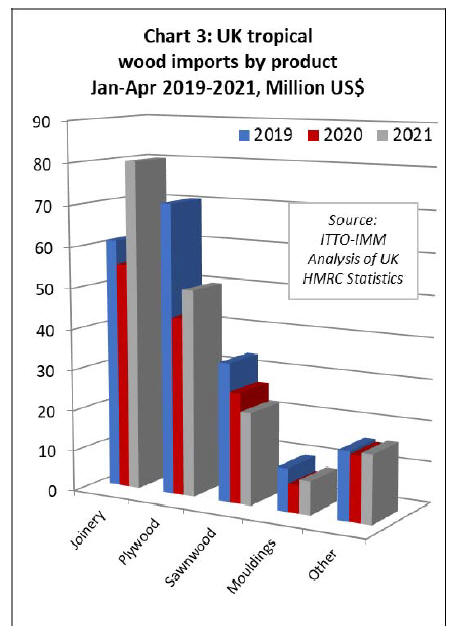
Comparing the first four months of 2021 with the same
period in 2020, UK imports of tropical joinery products
increased 45% to USD80 million while imports of tropical
plywood increased 16% to USD50 million and imports of
tropical mouldings/decking increased 20% to USD8
million. These gains offset a 16% decline in tropical
sawnwood imports to USD23 million (Chart 3 above).
After the sharp dip in UK imports of tropical joinery
products during the first lockdown period in Q2 2021,
imports gradually built momentum until March this year
and then surged in April. Imports from Indonesia, mainly
consisting of doors, were USD46 million in the first four
months of 2021, 46% more than the same period last year.
UK imports of joinery products from Malaysia and
Vietnam (mainly laminated products for kitchen and
window applications) also made strong gains in the first
four months of 2021.
Imports from Malaysia were USD20 million between
January and April this year, 34% more than the same
period in 2020. Imports of USD5.2 million from Vietnam
were 63% more than in the same period in 2020. UK
imports of joinery products consisting of tropical
hardwood from neighbouring Ireland also increased by
159% during this period, to USD3.8 million (Chart 4).
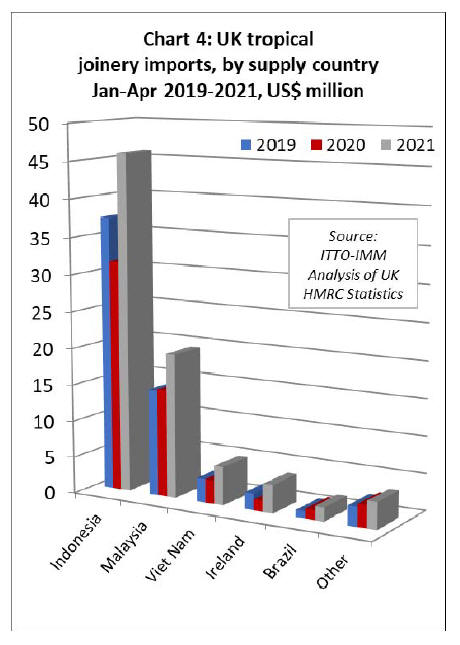
In the first four months of 2021, the UK imported 99,100
cu.m of tropical hardwood plywood, 22% more than the
same period in 2020. Imports from the UK¡¯s three largest
suppliers of tropical hardwood plywood ¨C China,
Indonesia and Malaysia ¨C have followed very different
trajectories this year (Chart 5).
The UK imported 40,000 cu.m of tropical hardwood faced
plywood from China in the first four months of this year,
51% more than the same period in 2020.
Imports from Indonesia also made gains during this
period, rising 36% to 20,400 cu.m. In contrast, imports of
22,700 cu.m from Malaysia in the first four months of
2021 were 6% down on the same period in 2020.
As with other hardwood product groups, UK demand for
tropical hardwood plywood has been strong this year,
driven by high levels of construction activity and
shortages of competing materials.
The main market challenges have been on the supply side,
notably the considerable escalation in freight rates on
Asian routes to the UK. In the past six months there was a
4-5 fold increase in container freights from South East
Asia. During December and January, this virtually halted
shipments of hardwood products from the region to the
UK.

After falling sharply in May and June last year, UK
imports of tropical sawnwood strengthened between July
and December but the momentum has slowed this year.
UK imports were 23,000 cu.m in the first four months of
2021, 23% less than the same period in 2020. Although
imports from Cameroon, now by far the leading supplier
to the UK, increased by 64% during the four month
period, imports from all other leading tropical sawnwood
supply countries declined (Chart 6).

The large increase in imports of sawnwood from
Cameroon was due to the long lead time in shipment of
contracts placed back in 2020. UK importers now report
that supply for hardwoods from Cameroon and other
African supply countries is very limited.
Global demand for species such as sapele, sipo and iroko,
accompanied by production delays and logistical
difficulties, have been such that many African mills placed
a moratorium on taking new orders in late March and
throughout April this year.
The few mills with capacity to take orders which can be
produced and shipped relatively quickly are taking
advantage with high premiums being requested.
Even African hardwood species such as ayous and
okoume are limited in supply, in part due to the fact that
consumer markets are seeking new alternatives to their
customary products such as American tulipwood which is
hardly available at present.
UK imports of tropical sawnwood from Côte d'Ivoire were
no more than 630 cu.m in the first four months of this
year, 56% less than the same period in 2020.
The UK was previously a significant buyer of framire
from Côte d'Ivoire but UK importers report that this
species is proving increasingly difficult to source, both due
to a lack of raw material in the forest and the challenges of
obtaining assurances of legality that satisfy UK Timber
Regulation requirements.
UK imports of tropical sawnwood from Malaysia were
only 1,300 cu.m in the first four months of 2021, 77% less
than the same period last year.
Imports from Malaysia have been severely affected both
by production problems during pandemic and extreme
shortages of container space. The latter has led to the first
breakbulk shipments of Asian meranti and keruing lumber
into the UK for nearly 30 years, with the first arrivals in
May (and therefore not appearing in these statistics).
With shortages in supply from other sources, UK
importers were turning more to Brazil in the opening
quarter of the year, but imports from the country slowed
again in April. In the first four months of 2021, total UK
imports of tropical sawnwood from Brazil were 1,500
cu.m, 20% less than the same period last year.
Indirect UK imports of tropical sawnwood from other EU
countries also fell dramatically in the opening months of
this year. Total UK imports from EU countries were 3,800
cu.m in the first four months of 2021, 29% less than the
same period last year.
The UK imported 2,700 tonnes of tropical hardwood
mouldings/decking in the first four months of 2021, 7%
less than the same period in 2020. Imports declined 38%
from Indonesia to 800 cu.m and were down 15% from
Brazil to 500 cu.m. These losses were only partly offset
by a 13% rise in imports from Malaysia to 800 cu.m and
by imports from the Netherlands rising from close to zero
to 300 cu.m this year (Chart 7).
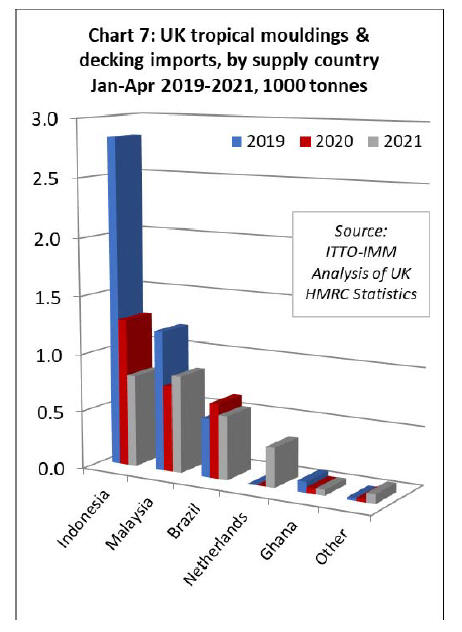
The TTF reports that the UK market is currently suffering
from severe lack of availability of bangkirai decking,
¡°initially due to the freight hikes at the beginning of the
year but, it seems, in the past 3 months or so, due to
suppliers selling UK bound stocks to other markets at a
time when the availability of (replacement) logs and
lumber suddenly dried up¡±.
The number of Indonesian mills offering bangkirai for sale
to UK importers is now very restricted and the few offers
being made are ¡°at prices about 50% higher than where
they were back in December which has led to significant
interest in cheaper Brazilian Decking species¡±, according
to the TTF.
UK timber imports from the EU at record levels despite
Brexit
An impact of the UK¡¯s departure from the EU single
market and customs union on 1st January this year was
meant to be a decline in the quantity of UK timber imports
from the EU.
This forecast followed expectations of logistical problems
as new controls were introduced at the UK border,
increased scrutiny of the plant health and legal status of
EU wood products imported into the UK, and sluggish
economic activity in the UK due to post Brexit
uncertainty.
However, not only did UK imports from the EU fail to
decline in the opening months of 2021, but they were at
record levels for the time of year.
Chart 8 shows the quantity of UK imports of all wood and
wooden furniture products from the EU (excluding wood
for fuel) on a monthly basis since the start of 2017.
Following the dip in imports with the introduction of the
first lockdown in April and May last year, imports
recovered strongly through to November. They cooled a
bit in December and January, but less than usual for the
time of year, and then rebounded rapidly between
February and April.
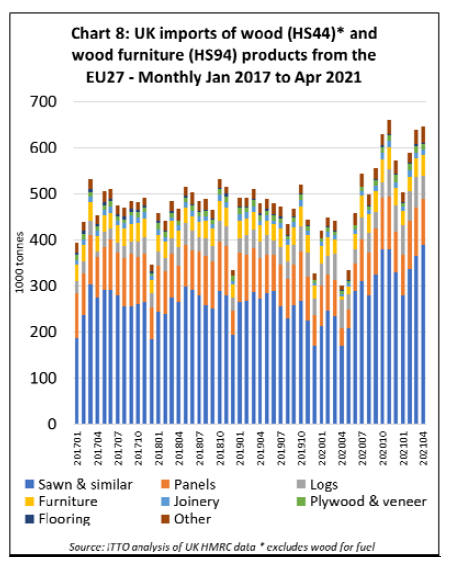
In total, the UK imported 2.38 million tonnes of wood
products from the EU27 in the first four months of 2021,
47% more than the previous year, which of course was
COVID-affected, but also 21% more than in 2019, the last
¡°normal¡± year. In fact, the quantity of UK imports of
wood and wooden furniture from the EU27 in the first four
months of 2021 was at the highest level since at least
2005.
Most of this growth was concentrated in softwood
sawnwood and logs and panel products, which dominate
UK imports from the EU27 (at least in tonnage terms).
However, imports of furniture and hardwood products
which compete more directly with imports from the
tropics also grew strongly from the EU in the opening
months of this year.
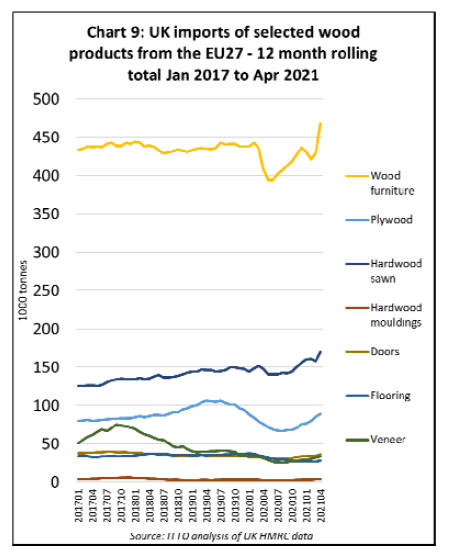
Chart 9 showing 12 month rolling total imports into the
UK from the EU27, highlights that following a sharp fall
in UK imports of wooden furniture from the continent
during the first lockdown in April/May last year, imports
gradually recovered in the second half of 2020. They then
weakened only slightly in January this year and surged in
March and April.
In contrast, a gradual long term rise in UK imports of
sawn hardwood from the EU seems to have been little
impacted by either the COVID lockdown or the UK¡¯s
departure from the single market.
UK imports of plywood from the EU27 fell sharply from
the middle of 2019, when the market was seriously
affected by over-stocking, and this downward trend
continued until the last quarter of 2020. However, UK
imports of plywood from the EU27 have been recovering
again this year.
Similarly, UK imports of flooring, doors and veneer were
all sliding throughout 2019 and 2020, but the downward
trend has haltered this year and there has been a slight
upturn.
Of course it is early days for the UK outside the EU single
market, and the UK timber market is currently
experiencing unprecedented conditions due to the COVID
pandemic. A massive government stimulus, including low
interest rates, a stamp duty holiday, and an additional £2bn
spending on infrastructure, has combined with a huge
surge in home and garden renovation activity as people
have either moved house or improved their existing
homes. Cash usually spent on vacations and other
recreational activities has instead poured into construction.
Meanwhile supplies of wood products from sources
further afield, in China, South East Asia, North and South
America, and Africa, have been severely disrupted. All
this has fed a huge upturn in UK demand for timber
imports from the EU and in prices which, for now, have
encouraged importers and distributors to overcome the
new logistical and bureaucratic challenges of sourcing
from the EU.
The only questions now are: for how long will this extraordinary
market situation in the UK continue; and, if and
when there is a return to ¡°normality¡±, will the longexpected
UK pivot away from the EU to other supply
sources then take place or will the UK¡¯s renewed
dependence on EU suppliers be maintained for the longterm?
|